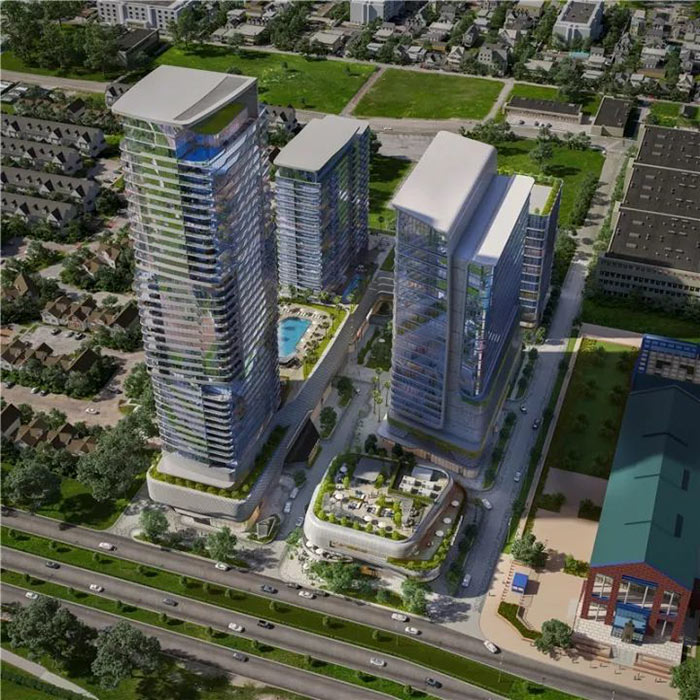
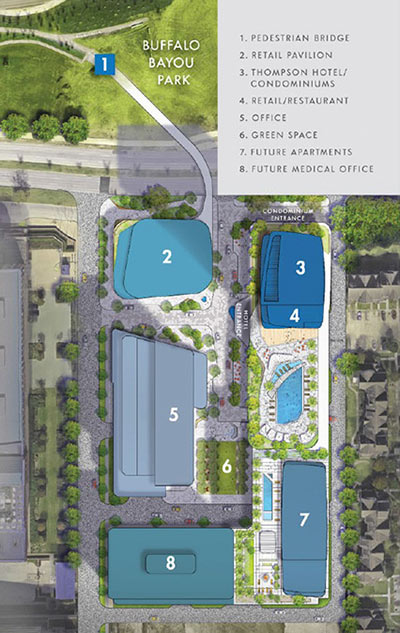
The renderings and site plan shown here give the clearest view yet of what DC Partners and Chinese firm Tianqing Real Estate Development have planned for their proposed 6-acre mixed-use development at Allen Pkwy. and Gillette St., now dubbed The Allen. The image at top shows a 42-floor tower, home to both a Thompson hotel and private condominiums, fronting Allen Pkwy. A 3-story retail building is depicted to its right; behind it is an office tower. The site plan also shows a future apartment tower and medical office building toward the back of the complex.
The development is planned across Gillette St. from the Federal Reserve building, on the northern portion of an industrial site that was home to one of the city’s first garbage incinerators. A pedestrian bridge linking the development to the bayou is absent from the rendering at top, but indicated in the site plan as well as other images of the complex:
***
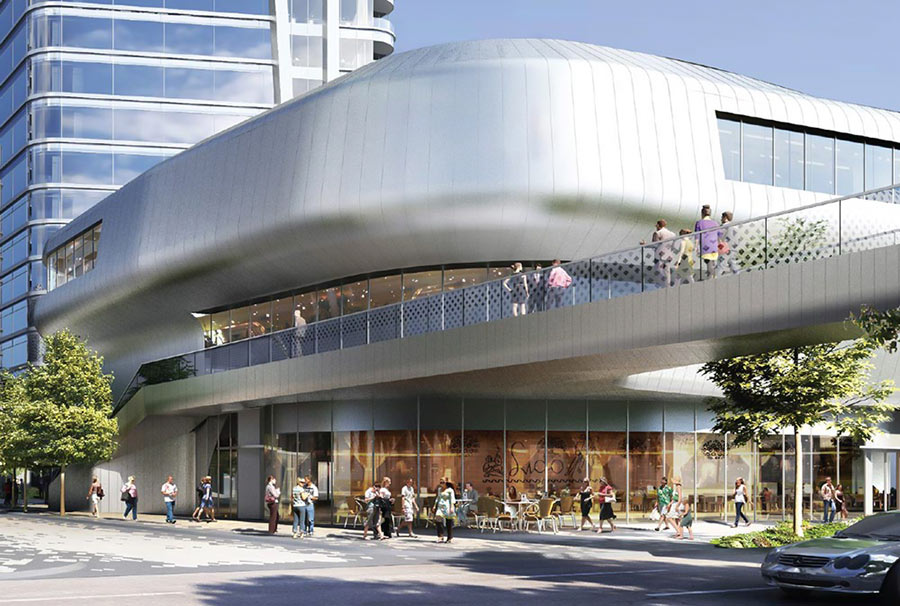
Below, an imagined view from Buffalo Bayou Park shows the complex serving as a buffer between the Fed on the right and a tree-shaded Allen Parkway Village on the left:
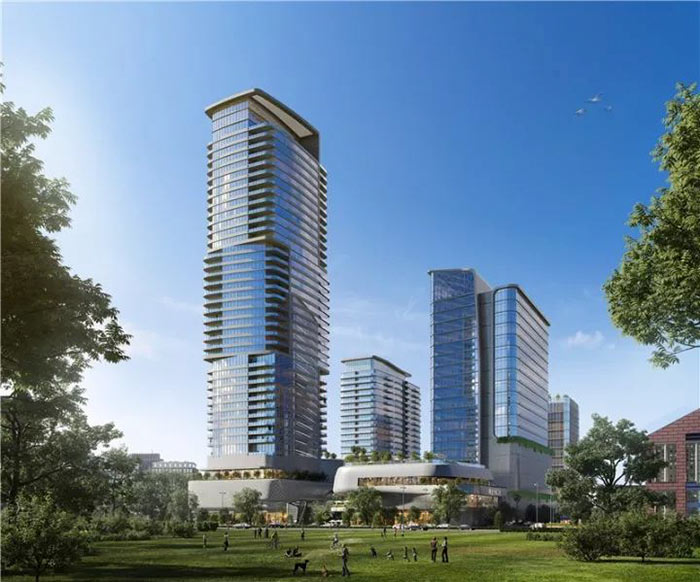
A sign for the Thompson hotel is visible between the trees in this next view, taken from Gillette St. The retail building is shown on the left, opposite the office tower:
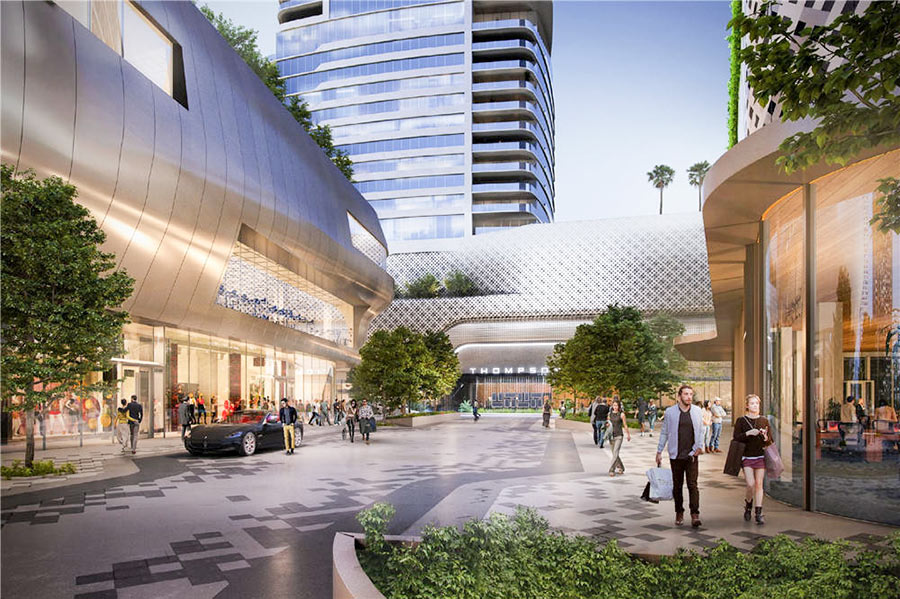
A green space is planned for the zone between the office tower and the future apartment and medical buildings.
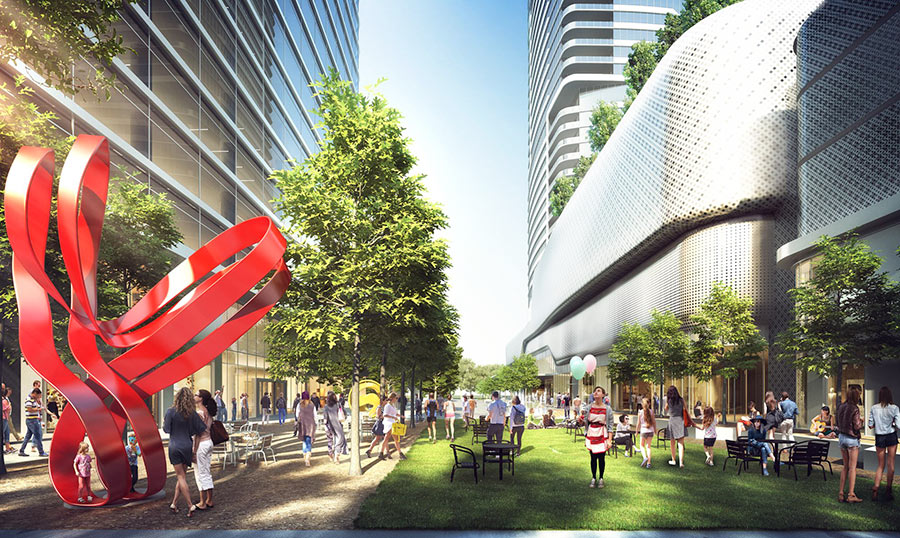
A recent brochure from DC Partners claims work on the project will start early next year.
- DC Partners Brochure [Issuu]
- Houston real estate is so hot, investors should rent to buy a house to whom? [Go Home Network]
- The Allen: Allen Pkwy/Gillette Mixed Use 6 acres [HAIF]
- Previously on Swamplot:Â New Gleaming Mixed-Use Visions of a Former Fourth Ward Incinerator Brownfield;Â The Mixed-Use Towers That May Rise from the Ashes of Allen Parkway’s Former Waste Incinerator Site; Comment of the Day: A Brief Annotated History of Allen Parkway Village’s Dirty Neighbor; City Selling Off Land, Streets, and a Park on Allen Parkway
Images:Â Tianqing Real Estate Development/DC Partners


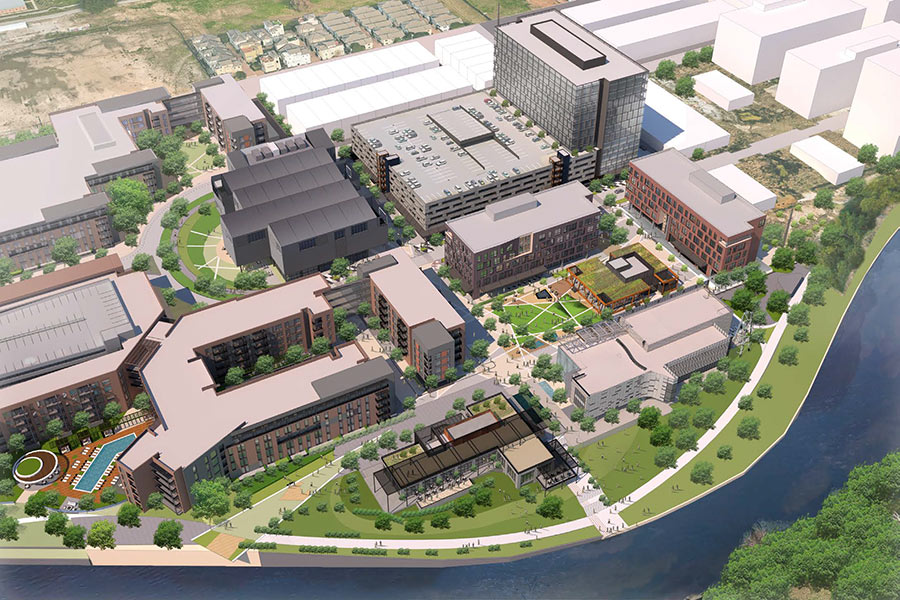

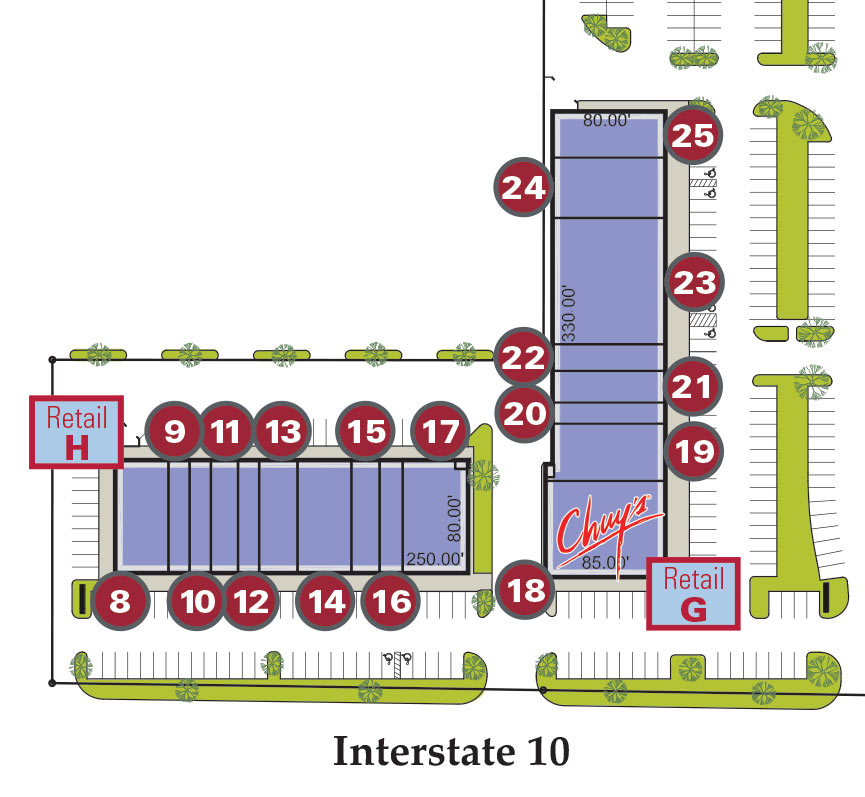
If these buildings keep creeping toward the downtown skyline their going to ruin the sweeping view of downtown. These buildings are very Mediocre. Hope this doesn’t get built.
Oh those will flood great! Did anyone hear of this thing called Harvey? We shouldn’t be building anything close to bayous anymore except trees that soak up water. These developers will build this crap, and sell to some other investors and take their money and run before the next Hurricane floods these buildings. And I thought Houston had a glut of commercial space and luxury apartments anyway? The city and county and state should condemn all the unbuilt land along the bayous and plant trees. And let the developers sue all they want, we’ve only known about these flooding issues forever.
@Scott – Yep, I’m pretty sure they heard of Harvey. Did YOU hear that not all of downtown and surrounding environs flooded? The water was several feet away from that property even with Harvey, so they’re not taking a big risk.
@Jonathan – Mediocre? I think they’re a danged site better than some of the boring blocks that make up that “sweeping view of downtown” you’re worried about. Our skyline hardly justifies restricting high-end development along one of the only nice sections of land we have near downtown.
I don’t have a problem with this complex being built, but I do notice the contrast of it going up next to single family subsidized housing. Imagine if there were a city code requiring new buildings to have a percentage of units designed to remain at or below current market value? In other words, 2 and 3 bedroom units with less square feet than others. Further, how about a grocery store going in nearby, or on the bottom floor. This complex is big enough to have medical services, but not groceries?
@GlenW There are plenty of grocery stores near this location. I live very close and have plenty of grocery stores to choose from. I would rather see APV moved elsewhere.
@ GlenW: The housing complex next door is Allen Parkway Village, owned by the Houston Housing Authority, and is mulitfamily, not single-family.
.
The trend in multifamily is toward smaller units and has been for better than a decade now. It’s not impossible to find three-bedroom units, but they are now much rarer than they once were. Forcing size reductions in new development is not really a very good avenue for cost control because units are already so small that most of the expense is related to per-unit fixed costs (i.e. mechanical, electrical, plumbing, sprinklers, parking, and impact fees). The variable cost associated with more square footage or partitioning off extra bedrooms is minimal, so you tend to see those somewhat larger units to provide a little bit of diversity in the unit mix and as a function of maximizing the yield of a tract given its unique shape and size. Note that highrise condo projects are different and tend to succeed with many many fewer units per building and by offering somewhat larger units.
.
In an ideal world, I think that the City should’ve recognized that there was an opportunity for the HHA to acquire this site and work with a private-sector master developer to completely demolish the existing complex and integrate government housing into a much more intensively developed project on this extremely high-profile site. Doing so would’ve bypassed some of the issues that they’ve since encountered with the adverse SCOTUS ruling. It wouldn’t have been cheap, but it would’ve also tastefully incorporated government housing into a project that could have mitigated the externality of APV on the areas around it and established an open street grid. Doing so would’ve made everything around there and along the Buffalo Bayou much more desirable and accessible, and leveraged the tax base upward over a large area. However, that also wouldn’t have been uncontroversial; some people think that the original Allen Parkway Buildings are architecturally significant enough to warrant their preservation. In any case, that ship probably has sailed.
.
You asked why this site can’t have some kind of grocer. There isn’t any reason it can’t. It may not be a full-service grocer, but they could certainly accommodate something like a Trader Joe’s. And that would be fine; there are full-service grocers around and the general area is hardly underserved. They haven’t announced any retail tenants yet. The medical office building is probably in there for the wrong reasons. Proposed MOBs that are hospital-affiliated tend to be successful at getting off the ground, and those that aren’t and aren’t even close to hospitals…well they’re either very small or don’t often get built. However, on the face of it, just considering construction costs, and market rents/occupancy, MOBs can look really good.
.
It’s worth pointing out that most of the projects that have chased Chinese investment are geared toward investors that are used to very high rates of return. Most of what they get pitched are projects in well-known ‘gateway cities’ for international investment like NYC or SF they are not familiar with Houston or Houston’s development patterns. Many of them have expectations that are not grounded in reality. Some US-based developers seeking Chinese investment may be aware of this but also know that if they aren’t proposing something eyecatching with very very aggressive underwriting that they’ll never even garner so much as a nibble. So…what I’m saying here is to stay tuned because plans like this often get ratcheted back into the realm of reality. These renderings are *not* a social contract with the public.
Thanks to the previous commenters, including TheNiche. I want to include a bit more context that goes back to the 1970s. (If anyone wants to add info going back further in time to Freedmens’ Town, I would enjoy that also.)
I recall American General (later absorbed into AIG) proposing that they wanted to redevelop the entire area according to a master plan of their design. Advocates for the poor people living in the area objected and their proposal became a hot potato. I also remember when Houston was considering a location for its new convention center to replace the Albert Thomas Hall and the site of Allen Parkway Village was proposed by Hines Interests, which lost out in favor of the current GRB site, partly because of political pressure intended to help the poor who lived in APV and the Fourth Ward in general.
Ironically, despite the apparent victories of the defenders of the 4th-Ward, they ultimately lost the war. The 4th Ward has been mostly redeveloped and in a much less desirable way. Sort of like the worst of all possible outcomes. The poor got shoved and the young (mostly white) millennials moved in to cheaply built townhomes with the same old ditches and lopsided electric poles along their inadequate streets.
There’s been far more cancelled high rises in recent years then there have been ground breakings. Good luck.
I’ll take it. Despite it’s introverted, plaza-esque design, it appears to have a decent relationship to Gillete Street.
#JustBuildIT
@Scott – Yes – water may flood the ground level – which will probably be a parking garage. Wouldn’t you think they thought of that before becoming willing to plunk down their millions of dollars into this plan? Everything else will be just fine. When the water recedes, they hose off the sidewalks and other concrete surfaces down there, and life goes back to normal. Not sure if you heard about Harvey – but a lot of flooding occurred away from the bayous – it’s not a simple issue of establishing a setback from the bayou bank – flooding is more complicated than that. Finally, simply planting trees does nothing to stop flooding. What’s your real angle here?
@Superdave, it is highly likely that some of the building machinery (pumps, elevator equipment, etc) will be in the lower garage levels. Why would you waste valuable above ground real estate on those things? Thus, not so easy just to hose off after a flood.
Yeah, I know how complicated flooding is, and I know that specific area was spared….THIS TIME…
Look people – Hydraulics 101, hard surfaces like roads and buildings that are close to waterways shed all the water that falls on them right into the waterways. The waterways fill up, and flood areas upstream as they can’t discharge the water fast enough. Trees can soak up hundreds of gallons of water each. It’s trees—forests— we need close to the waterways, not buildings, not roads. We or maybe our great great grandchildren are going to have these forests close to the waterways, because climate change is going to make rain events like Harvey more frequent in the future, and the land close to waterways will cost more and more to insure for flood damage until it’s cheaper to condemn it and plant trees. It’s irresponsible, and short sighted, and selfish for people to look the other way when projects like this go forward. Houston and Harris County must come to terms with climate change or we will be another Detroit. Is that plain enough for you?